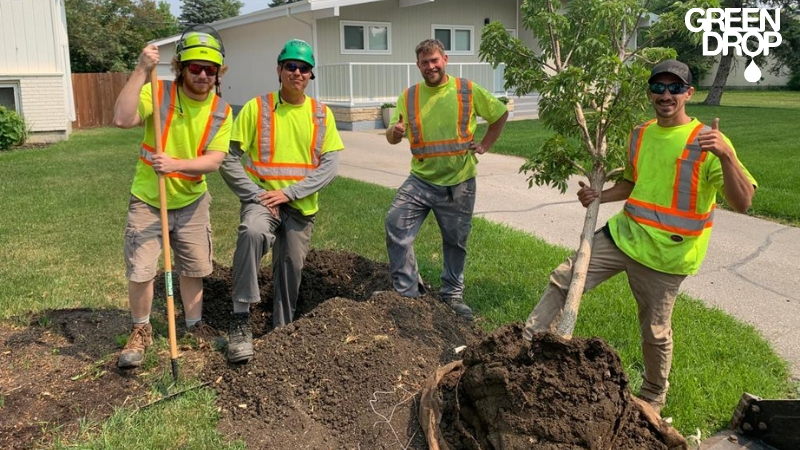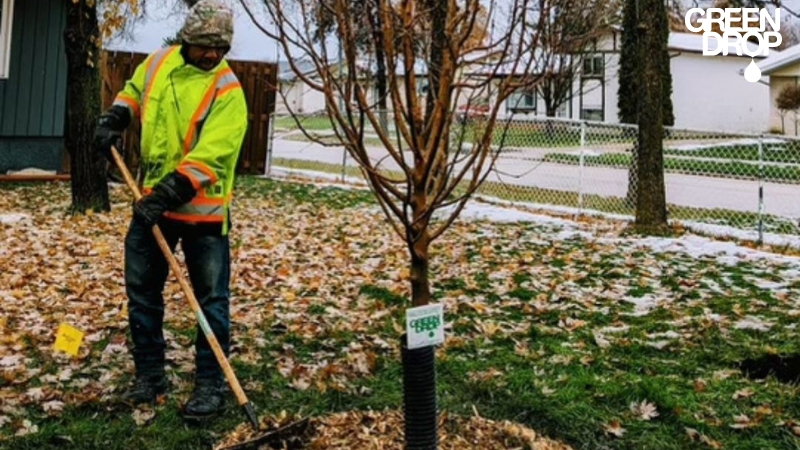How to Keep Your Tree Roots from Damaging Sidewalks – A Guide by Saskatoon Tree Care Experts
Reading time: 6 minutesIf you’ve ever seen a broken sidewalk next to a tree, this is likely caused by root heave. Root heave occurs when tree roots in search of water, oxygen, and nutrients push up against sidewalks or parking lots from beneath. This causes the concrete to crack and break, creating an uneven surface that not only looks bad but is a significant tripping hazard.
In this blog, we go over ways to keep healthy tree roots from damaging your Saskatoon property or the sidewalk, as well as what to do if you find yourself presented with this problem.

Understanding Tree Bylaws in the City of Saskatoon
Like many places in Western Canada, Saskatoon takes the health of its trees seriously. In 2024, the City passed a new tree bylaw that aims to protect trees with half or more of their trunk on municipal property.
Homeowners, tenants, and businesses that want to make any changes to these trees must get permission. Even if the tree is on your property, as long as 50% or more is also on city grounds, a permit will be necessary.
How To Stop Pavement Lift From Tree Roots – Top Root Heave Prevention Tips
Prevention is the best policy when it comes to dealing with root heave. It’s much easier to implement strategies to prevent roots from reaching the point where they pose a risk to sidewalks and other nearby structures than to deal with them afterward.
Here are our top tips for preventing root heave:
Plant Your Tree Properly

One way to avoid damage to a nearby sidewalk is to plant trees correctly. Unsurprisingly, where and how you plant has a marked effect on tree health since this can determine a tree’s access to water and nutrients and its exposure to pests and diseases.
Here are some tips for tree planting that can increase your chances of success:
- Check your soil’s texture. Good soil feels soft, moist, and lightly crumbly.
- Improve soil quality. Green Drop’s RootBoost is a nutrient-rich elixir with over 70 essential minerals and nutrients that your lawn and trees will need to thrive.
- Choose tree varieties that are resistant to pests and disease.
- Order trees from your nursery in advance before popular varieties sell out.
- Plant fewer trees to avoid too much competition for resources.
- Plant them in a good location where plenty of sun, water, and oxygen can reach them.
- Consider the size and shape of the mature tree before planting.
- Put down about 2 to 5 inches of mulch around the tree's base to hold moisture and protect delicate tree roots.
Put Down a Layer of Gravel Before Pouring Concrete
If you're pouring a sidewalk or driveway over tree roots, you can reduce the risk of damage later on by putting down a layer of gravel first. This ends up "sandwiched" between the tree's roots and the new concrete, encouraging the roots to continue growing underneath the gravel instead of pushing through the concrete.
This is because the open spaces between the rocks allow more water and oxygen to penetrate. That means tree roots don't have to search upward for the nutrients they need to grow. Gravel is inexpensive and easy to put down, making it a simple preventative measure you can take to protect both the tree and your new sidewalk in the future.
Leave Space Between the Sidewalk and the Tree
If there’s enough room, consider leaving space between the tree and the sidewalk you’re putting down. You can curve the sidewalk around the tree to give more space for large roots so there’s less risk of them pushing up from underneath the concrete.
To do this, measure where the tree’s drip line is (this is the outermost edge of the leaves) and install your sidewalk another several inches away from that. While shallow, the root system can grow as far as 2 to 3 times the total circumference of the tree’s crown. Giving tree roots as much space as is practicable when installing a sidewalk can lower the chances of heaving.
Make the Concrete Slabs Thicker
Another trick to hopefully discourage the possibility of sidewalk damage is to pour extra-thick concrete. You can also do this alongside other suggestions on this list, like putting down gravel first. When your concrete is thin, tree roots don’t have to do much to start putting cracks in the sidewalk. Thick slabs are much harder to damage and can withstand more pressure from roots that are pushing up on them.
What to Do If There Are Tree Roots Already Breaking Your Concrete
If you’re already dealing with an issue of root heaving with your sidewalk or driveway, there are a couple of options that may be available to mitigate the situation:
- Bridge the roots. You can pour concrete over a supporting structure on a root-broken sidewalk to create a “bridge” effect. While this leaves the appearance of a bump in the sidewalk, it’s smoother and more accessible for wheelchairs and bicycles than cracks.
- Tree removal. In cases where roots can’t be cut without damaging the tree and no other remedies are available, a tree may need to be removed. New trees may be planted if they’re away enough from the sidewalk so as not to cause more damage as they start growing.
Things to Avoid When Tree Roots Are Encroaching Your Sidewalk
In addition to the things you can do to help, there are also several things you should avoid if you find yourself in this situation:
- Don’t wait. The longer you wait to fix the problem, the worse the problem will get.
- Don’t cut the roots. You could risk doing serious or even life-threatening damage to the tree.
- Don’t use band-aid solutions. Temporary resolutions are just that and only serve to defer the problem until a later date. Again, this only allows tree roots to continue to grow and cause damage.
Instead, it’s best to contact an experienced arborist as soon as possible to come have a look at the issue. They can make recommendations for the next steps to take, help you secure the right permit, etc.
Depending on the extent of the damage, you may not need to remove and re-pour the broken concrete slabs. It might be possible to patch the damage or create a bridge that covers the cracks and makes a smooth surface for walking or riding bicycles.

Do You Need the Help of Certified Arborists?
If your tree roots are causing your sidewalk to buckle (or if your sidewalk is breaking because of someone else’s tree), our team of experienced ISA-certified arborists can evaluate the situation and recommend the best tree care services to help.
We also offer comprehensive tree care packages that provide nutrients and protection to trees all year long, keeping them healthy and beautiful for years to come! No matter what kind of tree health care services you need, our experience and training are up to the task. Contact us to get a free estimate.
We serve Saskatoon and the following areas in Western Canada: Winnipeg, Calgary, Edmonton, Red Deer, and Regina.

